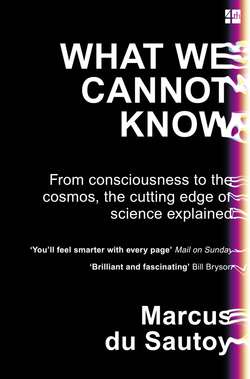Читать книгу What We Cannot Know: Explorations at the Edge of Knowledge - Marcus Sautoy du - Страница 7
WHAT WE KNOW
ОглавлениеIf I look back to the Seventies when I was at school and compare the things that we knew then to what we know now, it is quite extraordinary how much more we have understood about the universe even in the half century that I’ve been alive. Technology has extended our senses so we can see things that were beyond the conception of the scientists who excited me as a kid.
The new range of telescopes that look out at the night sky have discovered planets like the Earth that could be home to intelligent life. They have revealed the amazing fact that three-quarters of the way into the lifetime of our universe the expansion of the universe started to accelerate. I remember reading as a kid that we were in for a big crunch, but now it seems that we have a completely different future waiting for us.
The particle colliders like the Large Hadron Collider at CERN (the European Organization for Nuclear Research in Switzerland) have allowed us to penetrate the inner workings of matter itself, revealing new particles – like the top quark discovered in 1994 and the Higgs boson discovered in 2012 – that were bits of speculative mathematics when I was reading my New Scientist at school.
And since the early Nineties the fMRI scanner has allowed us to look inside the brain and discover things that in the Seventies were frankly not even considered part of the remit of scientists. The brain was the preserve of philosophers and theologians, but today the technology can reveal when you are thinking about Jennifer Aniston or predict what you are going to do next even before you know.
Biology has seen an explosion of breakthroughs. In 2003 it was announced that scientists had mapped one whole human DNA sequence consisting of 3 billion letters of genetic code. In 2011 the complete neuronal network of the C. elegans worm was published, providing a complete picture of how the 302 neurons in the worm are connected.
Chemists too have been breaking new territory. A totally new form of carbon was discovered in 1985, which binds together like a football, and chemists surprised us again in 2003 by creating the first examples of graphene, showing how carbon can form a honeycomb lattice one atom thick.
And in my lifetime the subject to which I would eventually dedicate myself, mathematics, has seen some of the great enigmas finally resolved: Fermat’s Last Theorem and the Poincaré conjecture, two challenges that had outfoxed generations of mathematicians. New mathematical tools and insights have opened up hidden pathways to navigate the mathematical universe.
Keeping up with all these new advances, let alone making your own contribution, is a challenge in its own right.
